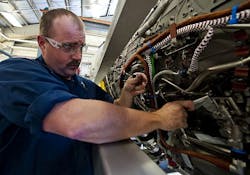Navy forced to invest quarter-billion dollars to safeguard electronic spare parts for F-35 jet
It stands to reason that at least some of the F-35's many sophisticated subsystems might have a difficult time with spare parts, since many of these parts have become obsolete and have gone out of production since the first F-35 prototype flew in 2000.
Not only is it difficult to keep a steady supply of spare electronic parts in stock for the F-35 and other high-technology military systems; it's expensive, too.
That's why the U.S. Navy -- contract agent for F-35 procurements for the U.S. Air Force, Marine Corps, and Navy -- had to earmark nearly a quarter of a billion dollars this month to help safeguard the electronic parts supply line for the F-35.
Related: Joint Strike Fighter ushers in a new generation of avionics subsystems and technology
Officials of the Naval Air Systems Command at Patuxent River Naval Air Station, Md., announced a $241.8 million contract on Tuesday to the Lockheed Martin Corp. Aeronautics segment in Fort Wort, Texas -- builder of the F-35 -- for diminishing manufacturing sources (DMS) electronic components.
Diminishing manufacturing sources refers to obsolescent electronic parts that the manufacturers have ceased producing, or that are nearing the ends of their manufacturing cycles.
The most direct way of dealing with DMS electronic parts is to make lifetime buys -- essentially buying up every part that manufacturers have on hand before stop production entirely. Even after making lifetime buys, systems integrators sometimes eventually must rely on aftermarket parts manufacturers, parts brokers, or the so-called "gray market" to keep spare electronic parts on hand.
It can be a time-consuming and expensive task to ensure that obsolescent parts remain available for military weapons platforms like the F-35, which must remain in top condition for many decades.
Related: F-22 avionics designers rely on obsolescent electronics, but plan for future upgrades
Without such a supply of spare electronic parts, systems integrators like Lockheed Martin would be faced with redesigning electronic subsystems with the latest generations of electronic parts. As attractive as that sounds, it's even more expensive and time consuming than keeping obsolescent spare electronic parts on hand.
Redesigning a complex electronic subsystem takes a long time, and an even longer time to certify for safety and performance. Most likely this quarter-billion-dollar investment the Navy is making in F-35 spare parts in the longrun will end up being a good deal.
On this contract to make sure spare electronic parts are available for the F-35, Lockheed Martin will do the work in Burlington, Vt., and Fort Worth, Texas, and should be finished by December 2018.
For more information contact Lockheed Martin Aeronautics online at www.lockheedmartin.com/us/aeronautics, or Naval Air Systems Command at www.navair.navy.mil.
Learn more: search the Aerospace & Defense Buyer's Guide for companies, new products, press releases, and videos
